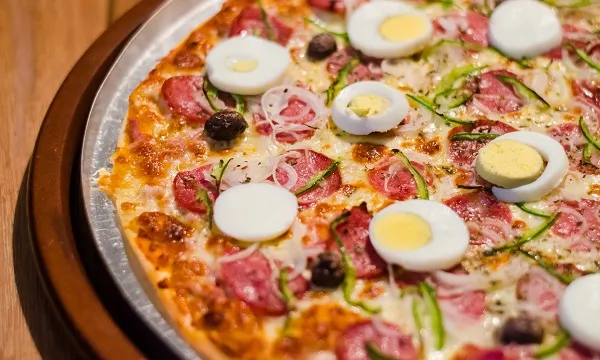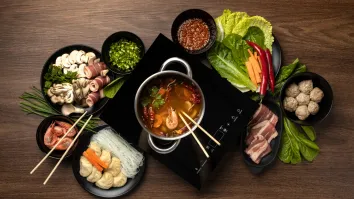
Will gourmet, premium pizzas be the next area for a price war?
Online ordering remains a key asset for pizza chains wanting a bigger share in the billion-dollar segment.
Gourmet and specialty pizzas are getting a bigger slice in a category that remains dominated by traditional pizza chains.
Whilst traditional pizzas continue to have the highest revenue share in the pizza industry, it saw a decline in the past year due to the increasing enthusiasm for premium food products.
Moving away from its cheap and convenient image, operators are embracing the market’s health consciousness, aiming to show that fast food can also offer premium and healthy products.
Family-owned and operated pizza chain Bubba Pizza now offers a selection of gourmet options alongside their contemporary toppings and standard items. The Melbourne-based brand started to include vegan options on their menu last year.
“The rise of veganism has certainly influenced a change in pizza offerings in the market and most people have adapted to it, but the important thing is how far are they willing to go,” Bubba Pizza business development manager Damian Hopper told QSR Media.
Retail Food Group-owned Crust Gourmet Pizza, which just introduced its BBQ Beef Brisket Pizza, is also looking into extending its “free-from” capability.
“Our consumers are becoming more health-conscious by the day. The demand for low carb, gluten free, meat free, vegan, Halal and lactose-free is increasing constantly and it’s our promise to continue thinking and creating adventurously for all of our customers,” QSR divisional manager Renee North said.
Recognising the growing global demand for plant-based offerings, Domino’s is set to roll out plant-based versions of their Beef & Onion pizza, Beef Loaded Burger and Beef Taco Fiesta this month.
New menus, online ordering drive growth
According to IbisWorld’s latest report, product innovation has been key to the industry’s revenue growth over the past five years as a result of a diversified consumer demand.
Industry revenue is expected to grow by 2.7% through 2018-19 to $3.4bn. It is forecasted to increase by an annualised 1.2% over the five years through 2023-24, to $3.6bn.
Premium pizzerias, IbisWorld says, have achieved a steady customer base since many consumers are willing to pay for higher quality food and ambience.
Whilst it has driven strong growth in revenue over the past five years and aided the expansion of the pizza industry, IbisWorld senior industry analyst James Caldwell said this also might be the next area for a new pizza price war.
“Over the past five years, operators have been able to introduce premium and healthier products at higher prices, as competition in these segments is lower. However, as operators expand their offerings of gourmet and healthy options, they will be less able to differentiate themselves on product offerings, and revert back to price-based competition,” Caldwell said.
IbisWorld says that operators will be forced to fight for market share by offering higher quality products at lower prices.
In addition to changing menus, convenience trends have also bolstered the demand for pizza and pizza-related products over the past five years. Industry operators have been focusing on customer convenience to combat competition from alternative fast-food options and ready-made products, as seen through technological innovations such as online ordering systems that are prevalent today.
For example, Pizza Hut announced the launch of its ordering platform accessible through the Facebook Messenger app. Pizza Hut Instant Ordering presents users with options such as delivery or pick-up and pizza type. It also features tokenised payments provided by Visa and Cybersource.
Large industry players typically invest in developing their own app or website whilst smaller operators have embraced third-party online ordering services.
“Takeaway delivery providers or aggregators have taken menu items that were previously only accessible via a dine-in experience and transported them into the family home. As a result, the consumer has been able to access more options than ever at the touch of a few buttons,” North said.
“With the exponential shift in online orders, mobile apps have been a major priority for the business to ensure its keeping agile and responsive to the ways customers engage with the brand.”
Hopper surmised that the last five years have been the “most challenging” in the pizza industry due to the ordering trends, stressing that other options being made available via an aggregator have made them direct competitors of the pizza industry.
“Pizza stores would traditionally consider a neighbouring burger store to be a benefit to them as they encourage more food eaters to the location, these days that same burger store might do most of his sales through delivery via an aggregator, so he has entered into your market,” he said. “The international fast food chains have entered the same market as well, so pizza stores are now in direct competition with the American juggernauts like McDonald’s and KFC. Five years ago, this was not a thing.”
Improving food quality and service
Besides increasing online demand, technology is also used by operators to improve the quality of food they offer. Caldwell said this allows the pizza segment to “better compete against more premium products”.
“These technologies have played much of a role in maintaining demand for traditional pizzas, rather their aim has been to boost the accessibility of pizza shops,” he added.
A notable example is Domino’s Pizza Checker, which made its nationwide rollout in May, aiming to improve the quality and consistency of their products across Australia and New Zealand. The brand said the technology has boosted their product quality scores by 15%, as rated by their customers.
With the rising competition in terms of premium product range and accessibility, what can pizza chains do to amplify their sales?
Caldwell says that although consumers demand for convenience and accessibility, there are other consumers, especially those with children, who enjoy dining out as a treat.
“Operators should appeal to these consumers, by ensuring their restaurants are family-friendly,” he said.
Echoing Caldwell, Crust and Bubba Pizza said their service in-store remains the key to their respective brand’s success.
“Service in-store remains key to the success of Crust. Service online via websites, apps, phone and delivery are just as important today as our customers migrate organically to these platforms expecting the same quality and speed of service,” North said.
“The experience customers have in store is important as it can demonstrate to the customer what lengths we go through to ensure that they enjoy a better pizza,” Hopper explained.
With reporting from Reyanne Louisse Ampong
























